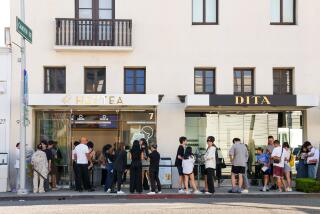Tantalizing Tea Making a Comeback in Japan
- Share via
TOKYO — With a couple of Starbucks and at least one other big-name coffee shop within easy walking distance, Tomohiro Tsuchiya would have been better off opening his little cafe somewhere else not long ago.
But he’s got a trendy product to offer -- tea.
Thanks to a major media advertising blitz by big tea companies, Tsuchiya is attracting a broad range of customers to his little teahouse and reaping a share of the huge swell in Japanese tea consumption.
“We are seeing a steady increase in customers each year,” he said.
Japan has long been the bastion of coffee-drinking in Asia, but shops are popping up all over that specialize in tea, from the trendy green variety to various brews of Chinese tea. Plus, bottled and canned tea is now taking up considerable shelf space in supermarkets, pushing its carbonated competition out of the country’s ubiquitous vending machines.
The sale of Japanese tea increased almost threefold from 1997 to 2001, going from 133.4 million gallons to 375.4 million gallons, according to a survey by the National Soft Drink Industry Assn.
As tea boomed, big-name competitors slowed or just held their own.
Sales of Coca-Cola, the most popular brand of soft drink, increased only 1.6% over those five years, from 304.3 million gallons to 309.1 million gallons.
The trend for coffee was similar, growing just 4.7%, from 678.4 million gallons to 710.1 million gallons.
Starbucks Coffee Japan Ltd. said recently that it expects to lose $4.2 million in the fiscal year that ends March 31. That was a sharp reversal from an earlier prediction of a profit of $8 million.
Starbucks, which operates more than 416 coffee shops in Japan, also said it has cut back planned store openings this year to 115 from 120 because of the “challenging” economy.
But tea is thriving.
“O-i, Ocha” by Itoen, Japan’s biggest tea company, is the most popular Japanese tea. Itoen has focused its sales pitch on purity: Its drink is straight, old-fashioned green tea with no sweeteners or additives.
Other popular teas blend well-known Chinese varieties or feature such unusual ingredients as barley, soybean and sesame.
Advertisements generally play up tea’s healthy image. It’s very low in calories and doesn’t promote tooth decay, obesity or diabetes. Some studies even indicate that it can suppress the development of certain kinds of cancer, although the scientific community hasn’t completely embraced tea’s supposed medicinal value.
Also to tea’s advantage is its long history in Japan.
Tea has been consumed in Japan for 1,200 years or so, and is served as everything from a simple meal accompaniment to the semi-sacred object of the famous tea ceremony.
“Other drinks have some limitations. They don’t go with Japanese food, for example,” said Sachiko Ine, spokeswoman for Coca-Cola of Japan, which also produces several tea-based beverages.
Perhaps the key factor in the growth of tea sales, however, has been the move by Itoen, Coca-Cola and other companies to flood the market with dozens of new tea brands that are heavily advertised on television.
“When we first started selling tea in a can in 1985, we were worried about whether people would buy it,” said Yuka Kawamura, spokeswoman for Itoen. “But over the past several years, the major producers have started advertising their tea products, and it’s changed the way consumers look at tea -- which has given the market a boost.”
Although some ads emphasize tea’s tradition -- one, for example, features a young kabuki actor drinking green tea -- most rely heavily on popular actresses or models to reinforce the idea that tea is cool, so young people need not be embarrassed to drink it in public.
More to Read
Inside the business of entertainment
The Wide Shot brings you news, analysis and insights on everything from streaming wars to production — and what it all means for the future.
You may occasionally receive promotional content from the Los Angeles Times.










